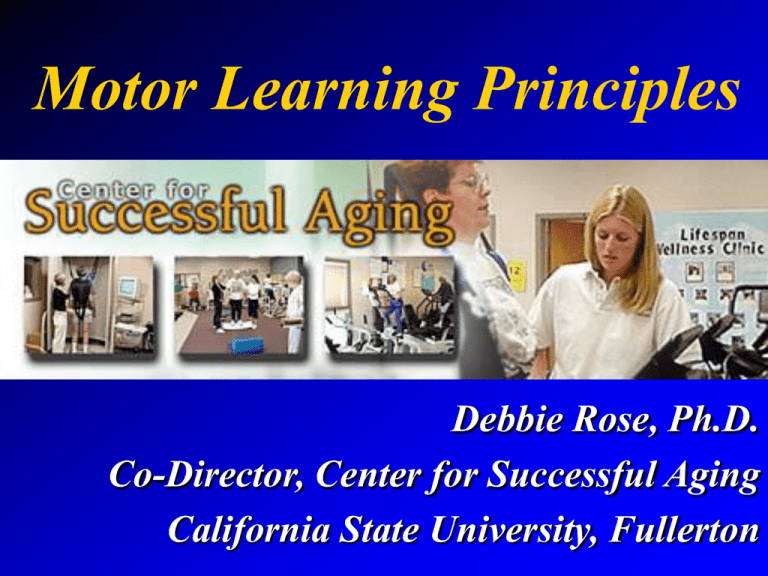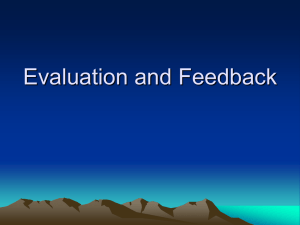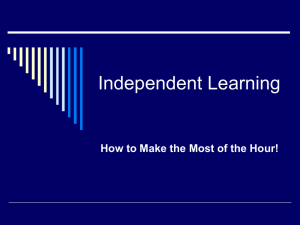Motor Learning Principles - California State University, Fullerton
advertisement

Motor Learning Principles Debbie Rose, Ph.D. Co-Director, Center for Successful Aging California State University, Fullerton Important Motor Learning Principles How best to introduce a skill • Modeling – correct versus learning models • Discovery Learning Techniques How to organize the practice environment • Practice variability – task demands versus environmental constraints How to provide feedback to clients in a meaningful way • Augmented Feedback Stages of Learning Gentile’s Two-Stage Model of Motor Learning: • Stage One: “Understanding the goal of the movement.” • Stage Two: “Adapting the movement pattern to the specific demands of the environment in which skill will ultimately be learned.” I: Getting the Idea of the Movement Learner begins to explore how different parts of movement must be coordinated to achieve the goal. Engages in trial-and-error practice. Learner begins to discriminate between environmental features important to the task. I: Getting the Idea of the Movement Regulatory Conditions • Environmental features that directly affect how the skill is to be performed. Non-Regulatory Conditions • Environmental features that do not, or should not influence how the skill is to be performed. • Example? Reaching for an object while standing on half-foam roller Regulatory Conditions •Size and shape of object •Distance and height of object from body •Width and compliance of support surface Non-Regulatory Conditions •Instructor clothing •Color of object •Proximity of other clients •Background noise/music STAGE TWO Learner attempts to adapt movement pattern to specific demands of environment in which task will be performed. • Stable • Variable Learner’s Goal? Fixate or diversify the skill Dependent on the type of performance environment in which skill will ultimately be performed. Practical Implications Most daily activities require that skills be diversified Regulatory conditions related to task demands or environmental constraints should be manipulated. Introducing the Skill to be Learned Traditional method is to provide verbal description of movement skill followed by one or more visual demonstrations Why? Believed to convey greatest amount of information in most meaningful form. Visual Demonstrations Most effective when a new pattern of coordination is being learned. Observing initially unskilled models may be equally if not more beneficial than observing a correct model. Why? • Learner more likely to engage in problem- solving activities versus imitation. • Underlying strategy used to accomplish skill not observable in case of skilled model. • Most effective when demonstration is supplemented with corrective feedback. Practical Implications Small group activities – one person serves as learning model and others in group are observers. Instructor provides corrective feedback on multiple trials before group practice begins. Alternative strategy - Performance checklists describing key elements of skill. • Fosters better understanding of skill to be learned. • Facilitates management of groups. Discovery Learning Self- or guided-discovery. Many skills to be learned in FallProof program are best learned implicitly. Example: Helping clients learn how and when to transition from one type of postural control strategy to another (ankle to hip) Verbally posing a movement problem or manipulating task demands and/or environmental guides learner to solution and fosters more problem-solving. Varying the Practice Environment Important to vary practice environment during second stage of learning Challenge can be manipulated by varying task and/or environmental demands Results in more varied practice environment that benefits learning of current and future skills. Valuable to vary practice environment when learning to fixate or diversify skill. The Practice Environment How practice environment is structured depends on: • Learner’s current level of skill • Characteristics of skill to be learned • Final performance environment – stable (unchanging) versus variable (changing). Varying the Practice Environment Regulatory and non-regulatory conditions should be manipulated when learning to diversify a skill. Non-regulatory conditions should be manipulated when learning to fixate a skill. Varying the Practice Environment How variations of one or multiple skills are practiced can also be varied. Increases level of contextual interference or variety introduced into practice environment. Variety further manipulated by varying practice according to a blocked or random practice schedule Varying the Practice Environment Blocked Practice Schedule • Particular skill is practiced for given number of repetitions before new variation of same skill or new skill is practiced Random Practice Schedule • Learner performs a skill or variation of skill only once before practicing a different skill or variation of skill on next repetition. Practice order is randomized Random schedules more cognitively effortful but appear better for learning Increasing Cognitive Effort Suitable Progression: Practice different variations of single skill according to blocked followed by random practice Follow same practice schedule (blocked to random) while practicing 2-3 different skills in same practice session. Varying the Practice Practical Example Stepping On and Off Benches: • Vary only height of bench and perform toe touches according to blocked then random practice schedule • Practice different skill variations on different height benches according to blocked then random schedule. Can match level of practice difficulty to learner capabilities easily. Benefits of Varying the Practice Environment Leads to better learning of movement skills Improves learner’s ability to transfer what has been learned between different environments and skills Results in more enjoyable practice environment, albeit more challenging. Delivering Feedback to a Learner One of most effective ways to assist learners identify and correct errors in performance Augmented feedback supplements feedback derived from internal sensory systems Can be verbal, visual, or auditory in nature Can be delivered during of after a performance. Delivering Feedback to a Learner Augmented feedback can provide learner with information about outcome of performance • Knowledge of Results (KR) Augmented feedback can also provide information about quality of the performance • Knowledge of Performance (KP) Augmented Feedback During stage One of Learning it is important to provide prescriptive feedback Informs learners about what they are doing wrong and how to correct it. During Stage Two of learning type of feedback becomes more descriptive. Begin to ask questions following attempts at a skill to foster error detection and selfcorrection in this stage of learning. Augmented Feedback Which type of feedback is most beneficial to learner? BOTH KR is beneficial for Four reasons: Can be used to confirm learner’s own assessment of internal sensory feedback Can help determine actual outcome in situations where own intrinsic feedback is insufficient Can motivate learner to continue practicing skill Limiting feedback to KR promotes self-discovery Augmented Feedback Important to remember that more is NOT better. Too much augmented feedback leads to over dependence Less feedback forces learner to rely on internal sensory feedback to make necessary skill corrections Less feedback leads to better learning and transfer of knowledge to activities of daily living. Conclusions Goal as instructor is to provide older adult learners with skills and strategies needed to accomplish variety of daily activities. Tasks vary in demands imposed and must be performed in different sensory environments Important to structure class sessions in manner that fosters problem-solving abilities







